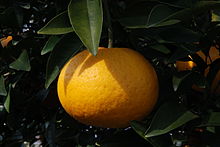- Amanatsu
-
Natsumikan / Amanatsu 
Scientific classification Kingdom: Plantae (unranked): Angiosperms (unranked): Eudicots (unranked): Rosids Order: Sapindales Family: Rutaceae Genus: Citrus Species: C. × natsudaidai Binomial name Citrus × natsudaidai
HayataAmanatsu (甘夏 ama natsu) is a yellowish orange citrus fruit, a group of cultivars of natsumikan (Citrus natsudaidai), which were discovered in 1740 in the Yamaguchi prefecture of Japan. Natsumikan is about the size of grapefruit and oblate in shape. The fruit contains 12 segments and about 30 seeds.
Natsumikan is grown commercially in Japan, notably in Kumamoto and Ehime prefecture. The rough textured fruit is easy to peel and is commonly eaten fresh. It is also used for wide variety of products ranging from marmalades to alcoholic beverages.
The natsumikan tree is believed to be derived from pomelo, Citrus grandis or Citrus maxima.

This Rutaceae article is a stub. You can help Wikipedia by expanding it.
